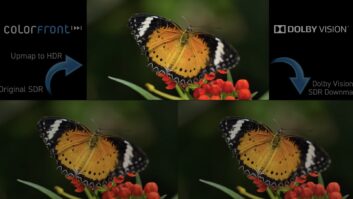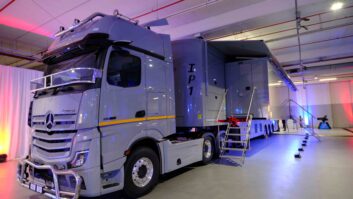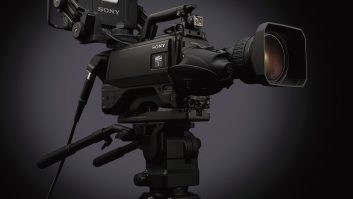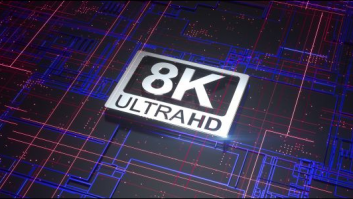Park Road has had a long association with director Peter Jackson, and together they had developed smooth workflows for handling stereo 3D. So even when the additional technical challenges of high frame rate were thrown into the mix, the team was confident the technical ducks were lining up and they could handle it.
The advantage of HFR is the freedom to move the camera quickly when needed, like in the big battle sequences, where the camera dives and swoops to track the action without judder. Some purists complained about the HFR effect as not being ‘film-like’, but in a sense that was the point. The new technology should not be ignored just because it is different.
Twice as many frames means twice as much data. Double that again because of course the film is shot in stereoscopic 3D. Storage is a problem, but throughput is a bigger one. At the time, there was no way of moving two streams of 48 frames a second in realtime, let alone display them.
A second challenge was that Jackson was keen to retain all of the dynamic resolution produced by the Red Epic cameras so he wanted to keep the 16 bit raw data, giving the equivalent of 13.5 stops all the way in to the final grade. So the data architects had to find a way to capture, deliver to post, edit, grade and composite the 5K resolution, 16 bit per colour output, 48 frames a second output of the Red camera. Two cameras per rig. As many as 16 rigs on a big battle sequence. Sometimes as much as 12 terabytes a day.
“When we knew that The Hobbit was coming along, and Peter was on board, we had a busy NAB,” recalled Phil Oatley, Park Road’s head of technology. This was April 2010. “We were doing some aggressive testing with all the usual post suspects,” he says. “Then, on the last day, we saw the most compelling demonstration we had ever had from a manufacturer.”
The demonstration was with Spanish company SGO. Its Mistika finishing system was already established as the best tool for stereo 3D and it was this that attracted the Park Road team to look at it. But Oatley adds: “We were utterly astounded by the rate at which SGO develops their platform”.
A week of testing in Wellington with SGO and Park Road established the workflow, which begins on set with some heavy-duty data wrangling. Park Road built trolleys they called ‘barbecues’, containing three Mac Pros, 64TB of storage, high end networking, and an LTO drive. The data team ran a QC pass on the data in realtime during ingest. The networking meant that barbecues on set in the studio connected directly to the Park Road servers. On location the fibre was replaced by duplicate LTO-5 tapes hand carried by trusted production runners.
Once in Park Road virtually every creative task was handled by SGO Mistika software. The typical Mistika configuration is an HP Z820 computer with an NVidia Quadro GPU. For The Hobbit, SGO worked with DVS on a 48fps video I/O board.
The first task was to derive an editorial version. This pass applied corrections to the 3D geometry where required, and a colour grade, to create an offline copy from the raw 5K data, as an Avid MXF.
In general the editorial version was just the dominant eye in 2D, but where 3D was required it was delivered in side-by-side format to make it completely transparent to HD infrastructure. This allowed the offline editors to work on standard Avids using HD televisions as monitors, even if they needed to see 3D.
The workflow also produced single eye MXF and MOV files as dailies for those who did not have to judge stereo. For department heads and leads files were delivered to iPads for quick checks on set. “There were a lot of iPads out there,” Oatley recalled. “They were all super-secured, of course, but it was a great way to get selected dailies out to lead crew in every department.”
“It is only when you get into the workflow that you realise some of the complications,” says SGO’s technical director Javier Moreno. “The offline created a 24fps EDL. When it came to conforming the online then all the live action and VFX were in 48fps, so you have to be able to support both frame rates on the timeline.”
Nine different formats
During the design of the workflow, Park Road decided they wanted to investigate performing the final colour grade in Mistika, too. While Mistika had always had colour correction functionality, the SGO team took this as a driver to develop both more sophisticated control and a new user interface.
“We worked closely with Dave Hollingsworth [supervising colourist on The Hobbit] and his team at Park Road,’ Moreno explains. “An important part of what they said they needed was already on our roadmap, but they pushed us in the right direction. The new colour grading toolset inspired by The Hobbit is now part of our standard product.”
Deliverables were as much a challenge as any other part of the project. Nine different formats were required, covering 2D, 3D, 48fps, 24fps and film, with 5.1, 7.1 and Dolby Atmos soundtracks, and six different home entertainment formats. All versions were exported in a single pass from the master Mistika files, with all versions of each reel created in around an hour.
I asked the Park Road team about where the problems and panics lay in the project. “It was pretty boring for war stories,” admits Oatley. “Nothing much went really wrong, thanks in no small part to SGO.
“We were seeking a relationship with a technology partner, and we found that SGO shares a philosophy with us,” he concludes. “What we demanded, and they delivered, was phenomenal.”
By Dick Hobbs
Photo credit: (L-R) Martin Freeman as Bilbo Baggins and Ian McKellen as Gandalf in the fantasy adventure The Hobbit: An Unexpected Journey, a production of New Line Cinema and Metro-Goldwyn-Mayer Pictures (MGM), released by Warner Bros. Pictures and MGM. Photo courtesy of Warner Bros. Pictures.







